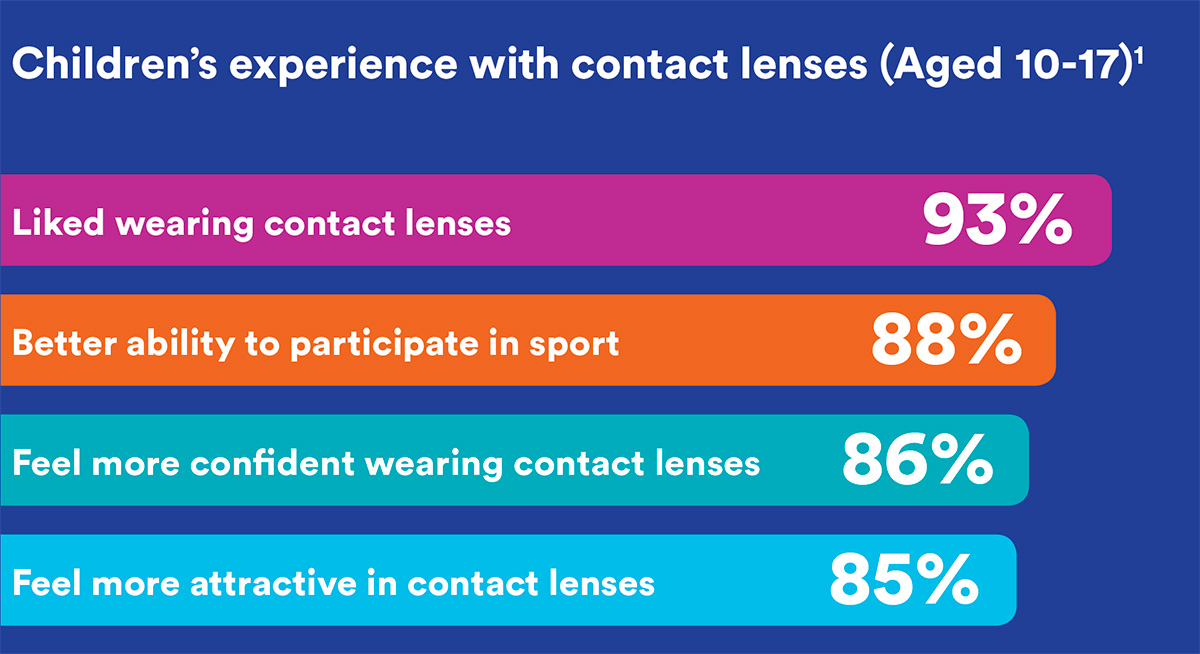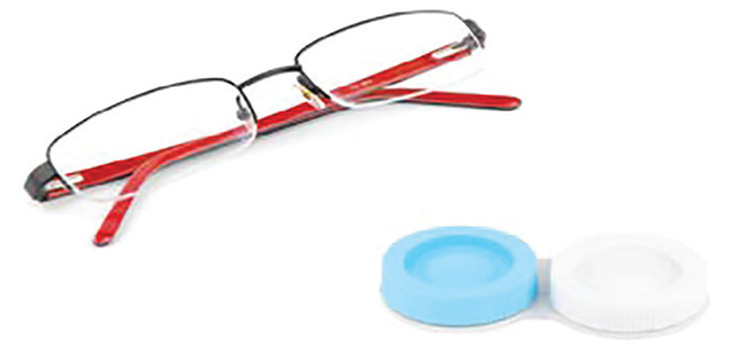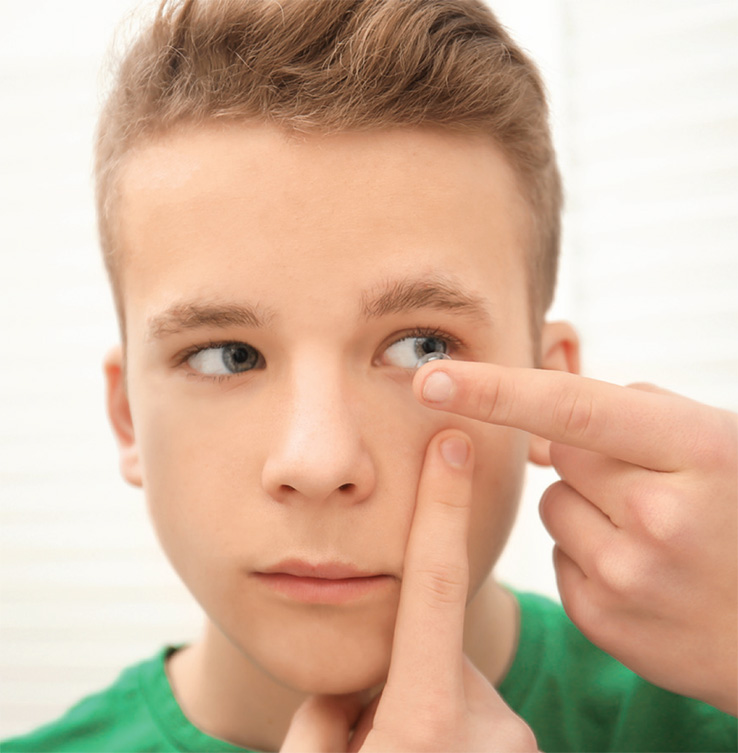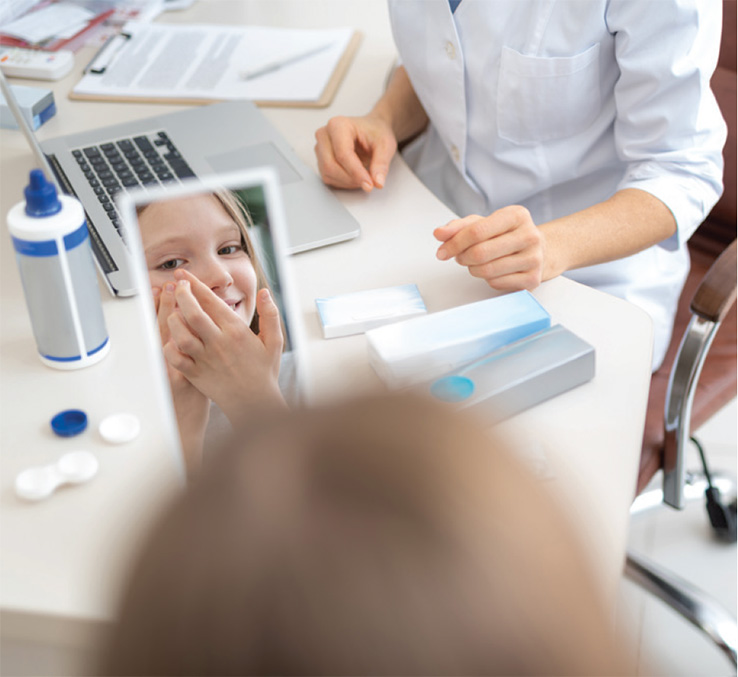By Stephanie Campbell and Amanda Davidson
Why initiate a contact lens conversation?
Why fit children and teens?
Evidence shows young people benefit from wearing contact lenses with 90% being able to successfully wear and care for their lenses.1 Researchers recommend that their use become more routine in pre-teen years.2 Currently 93% of practitioners prescribe contact lenses to children under 18, but few offer them to young children; with parents of under 10s being much more likely to initiate the discussion than practitioners themselves.2

Benefits include
- Improved quality of life – increased confidence in sports and social situtations.3
- Safety benefits for sports – ideal for sports where spectacles are either impractical or not permitted and ability to wear safety goggles over the top.
- Better vision than glasses – particularly for those high ametropes or anisometropes - very young children stand to benefit hugely from early consideration of contact lens wear.
- Myopia control – by 2050 it is projected 55% of the UK population will be myopic. Early efficacy studies seem to show promising results for soft multifocal lenses4 and orthokeratology.5
Use literature
- Confidently communicate lens safety – parents may have been misinformed by other practitioners/online articles.
- Have specific leaflets for young people when it comes to practising handling, with diagrams, photographs or videos using patients of similar ages.
Get support staff on board
- Having trained and enthusiastic support staff is vital to successful fitting of young people. Consider the role of ‘contact lens buddy’ to break down any barriers for the family.
- Ensure your practice and staff are child friendly! Offering free Wi-Fi for children to use in the waiting area and accommodating siblings while the child is being seen are just some of the ways your team can help.
- Parents should always be included when dealing with younger children, but language and techniques should be adjusted to match the needs of the patient.

What to look and listen for
Build rapport
By spending time getting to know your young patients you can establish what their interests/hobbies are and then discuss if contact lenses would help them enjoy these things more.
- Ask ‘Is there anything you’re doing at the moment that you think you’d do better if you didn’t have to wear your glasses?’
- Listen for clues about when they remove their glasses - this may include sports or performances.
- Are they simply afraid of losing or breaking their glasses, or are the spectacles hindering them in any way?
- Are the parents aware that they do this?
- Simulating to parents their child’s unaided vision can help them understand the benefit of CL correction.

Getting the parents on board
- 82% of parents with vision corrected children say their child’s positive self-esteem is absolutely critical to them.1
- Contact lenses are now available to help reduce myopic progression which could have benefits for the patient later in life with respect to reduced risk of pathology.5
Invite parental concerns, addressing them with current evidence
‘My child won’t look after them’ – we know that young people age 8-11 are just as capable as those aged 12-17 at looking after contact lenses.6
‘My child’s eyes are still growing’ – children’s corneas have reached adult size before they are 5 years old.

Ready for aftercare
For young children, ask them to complete a wearing chart until their first review to include:
- Time of lens application/removal each day
- ‘Days off’
- Any handling issues or questions
Consider using a compliance ‘quiz’ to test children’s knowledge of care procedures Ask them to demonstrate their care and handling.
Look out for achievements once fitted
Once fitted it is the visual and social benefits that motivate children and teens to succeed with contact lenses. Look for achievements resulting from contact lens wear such as:
- ‘Most improved player of the week’ award for a 10-year old rugby player
- Successful audition for performers
- A new activity the child starts to participate in
What to say and do
The 3Ms
Motivation, Maturity, Mother (or Father!)
Interest, motivation, maturity and ability to care for contact lenses are seen as more important considerations when recommending contact lenses than age. Establishing if the child is responsible enough to look after the contact lenses and their eyes can be difficult. Try ‘do you need to be reminded to brush your teeth?’
Parents need to fully appreciate the benefits for their child and be reassured about the safety of lens wear. It is vital that the child and parent understand that contact lenses are not a total replacement for spectacles. We should strive to explain the importance of a combination of vision correction options.

Adapt your technique
Use child friendly language – ‘homework’ could be given to practise holding their lids or asking them to read their written instructions carefully as you may ‘test’ them next time. Consider having a quiz or online tips available for young adults.
Allow sufficient time to put everyone at ease. You may consider breaking the fitting into 2 separate appointments if you feel this could help.

The first appointment (pre-fit)
Elicit needs, potential complications and establish ‘ground rules’. Consider asking them to sign an easy to understand ‘agreement’ so that they carefully consider undertaking lens wear. Allow them to play with the lenses. Tearing them apart tests their strength and showing them drying out/rehydrating shows how they work.
An anterior eye assessment with fluorescein/lid eversion allows you to judge how well they are likely to react to lens application at the next visit.
The second - Introducing and fitting the lenses
To allow the child to understand how the lens sits, consider demonstrating on a colleague or model eye. For young children, you can use a teddy bear or doll to help explain the process.
Fully engage with and ask permission before you do anything – this helps them to feel in control.
If a child or teenager is struggling and frustrated, rebook for another day – for those sporty kids an ‘everything gets better with practice’ phrase can help whereas for a despondent teen try ‘Would you be as willing to give up on a level of your favourite computer game?’

